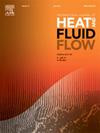Heat transfer and flow characteristics of supercritical carbon dioxide in nanochannels
IF 2.6
3区 工程技术
Q2 ENGINEERING, MECHANICAL
International Journal of Heat and Fluid Flow
Pub Date : 2025-04-18
DOI:10.1016/j.ijheatfluidflow.2025.109852
引用次数: 0
Abstract
As the integration density of micro-nano electronic devices continues to increase, utilizing nanochannels for thermal management has emerged as a promising approach. Supercritical carbon dioxide (scCO2) serves as an efficient coolant that can readily achieve a supercritical state within nanochannels, due to confinement effects and interactions with the channel walls. However, its behavior and applications in nanochannels have been less extensively explored. In this study, nonequilibrium molecular dynamics simulations were used to investigate how interface wettability, wall temperature, and applied force affect the heat transfer and flow characteristics of scCO2 in nanochannels. The results indicate that interface wettability significantly affects the heat transfer characteristics and slip length at the wall-fluid interface. Under strong wettability, the interfacial thermal resistance is two orders of magnitude higher than those under weak wettability. Specifically, the interfacial thermal resistance is 3.01 × 10-10 (K∙m2)/W under strong wettability and 5.22 × 10-8 (K∙m2)/W under weak wettability. Similarly, the slip length is −0.204 nm under strong wettability and 0.755 nm under weak wettability. While the wall temperature and applied force exhibit minimal impact on interfacial heat transfer, they significantly influence the slip length. At 700 K, the slip length is 0.106 nm, whereas at 400 K, it decreases to −0.113 nm. Furthermore, when the applied force is increased fivefold, the slip length increases from −0.041 nm to 0.067 nm. Finally, the vibrational density of states, liquid structuring and density depletion length were analyzed to clarify the mechanisms governing interface heat transfer and flow characteristics.

超临界二氧化碳在纳米通道中的传热与流动特性
随着微纳电子器件集成密度的不断提高,利用纳米通道进行热管理已成为一种很有前途的方法。超临界二氧化碳(scCO2)作为一种有效的冷却剂,由于约束效应和与通道壁的相互作用,可以很容易地在纳米通道内达到超临界状态。然而,其行为和在纳米通道中的应用尚未被广泛探索。本研究采用非平衡分子动力学模拟研究了界面润湿性、壁面温度和作用力对纳米通道中scCO2传热和流动特性的影响。结果表明,界面润湿性对壁面-流体界面的换热特性和滑移长度有显著影响。在强润湿性条件下,界面热阻比弱润湿性条件下高2个数量级。其中,强润湿性界面热阻为3.01 × 10-10 (K∙m2)/W,弱润湿性界面热阻为5.22 × 10-8 (K∙m2)/W。同样,强润湿性下的滑移长度为- 0.204 nm,弱润湿性下的滑移长度为0.755 nm。虽然壁面温度和施加的作用力对界面传热的影响很小,但它们对滑移长度的影响很大。在700 K时,滑移长度为0.106 nm,而在400 K时,滑移长度减小到- 0.113 nm。此外,当作用力增加5倍时,滑移长度从- 0.041 nm增加到0.067 nm。最后,分析了状态的振动密度、液体结构和密度耗尽长度,阐明了控制界面传热和流动特性的机制。
本文章由计算机程序翻译,如有差异,请以英文原文为准。
求助全文
约1分钟内获得全文
求助全文
来源期刊

International Journal of Heat and Fluid Flow
工程技术-工程:机械
CiteScore
5.00
自引率
7.70%
发文量
131
审稿时长
33 days
期刊介绍:
The International Journal of Heat and Fluid Flow welcomes high-quality original contributions on experimental, computational, and physical aspects of convective heat transfer and fluid dynamics relevant to engineering or the environment, including multiphase and microscale flows.
Papers reporting the application of these disciplines to design and development, with emphasis on new technological fields, are also welcomed. Some of these new fields include microscale electronic and mechanical systems; medical and biological systems; and thermal and flow control in both the internal and external environment.
 求助内容:
求助内容: 应助结果提醒方式:
应助结果提醒方式:


